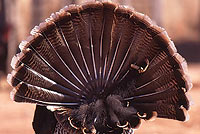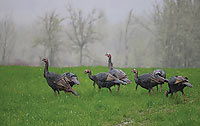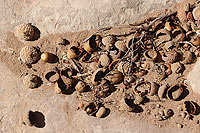 November is turkey time. Not just the traditional Thanksgiving meal but a time to reflect on the plight of wild turkeys across the centuries.
November is turkey time. Not just the traditional Thanksgiving meal but a time to reflect on the plight of wild turkeys across the centuries.
This tale also isn’t just about the bird but involves the Aztecs, Ancestral Puebloans, Spanish conquistadors, European migrants, and modern-day folk. Even Ben Franklin gets in on the action.
Native to the America’s, fossilized wild turkey bones have been unearthed dating back to over 5 million years ago. In California’s La Brea Tar Pits, bones of the extinct California turkey (Meleagris californica) were recovered alongside those of saber-toothed cats and dire wolves, dating back 10,000-12,000 years ago.
The transition from a hunter-gatherer lifestyle to an agrarian society involved the often-mentioned cultivation of corn, beans, and squash. But what about turkeys?
Some believe domestication of turkeys happened as two independent actions, by the Aztecs (over 3000 years ago) and by the Ancestral Puebloans in the Southwest. Perhaps Kokopelli carried the idea in his backpack to the Four Corners region along with copper bells and parrots.
In the Southwest, researchers believe the animals were initially raised more for their feathers than as a food source. Also, these early inhabitants switched from making blankets from rabbit’s fur to turkey feathers in the first couple of centuries C.E.; hence, the need for feathers would have been substantial.
A molting turkey yields about 600 useful feathers to make a blanket. Consider that a 2- by 3-foot turkey feather blanket or cape requires about 15,000-16,000 plumes which are woven around about 100 feet of yucca cordage and you can see the need for a steady supply of feathers from a flock of birds.
In the early 1500s, Spanish explorers returned home with domesticated turkeys brought back from Mexico. The large, tasty birds soon became popular and when English colonists voyaged to the New World in the 1600s, they brought turkeys with them as a food resource. Turns out, turkeys were widespread across parts of America at that time but they didn’t fare well with the hungry newcomers.
Ben Franklin, the American diplomat, is often associated with the turkey becoming the fledgling nation’s national bird, but that is incorrect. He commented, in a letter to his daughter, that the original design of a bald eagle image for the Great Seal resembled a turkey. He commented that the eagle was, “…. a Bird of bad moral Character…”, nothing better than a lazy pirate. Though he praised the turkey for its native origins and courage, he didn’t actually propose it as the national symbol. John Adams wanted the eagle and Thomas Jefferson argued for the dove.
Westward expansion across North America didn’t favor the turkey. By the early twentieth century, wild turkeys were extirpated across much of their native range. Farm-raised turkeys were released into the wild but they didn’t have the “savvy gene.” Trapping of wild turkeys and relocating them had better success in the 1940s, and groups such as the National Wild Turkey Foundation and state wildlife agencies became involved in this conservation action. Today, turkeys are found throughout the U.S. and parts of Canada.
So, this holiday season, give thanks to the turkey (along with family, friends, health, and safety) and raise a glass to this magnificent creature and its colorful history.